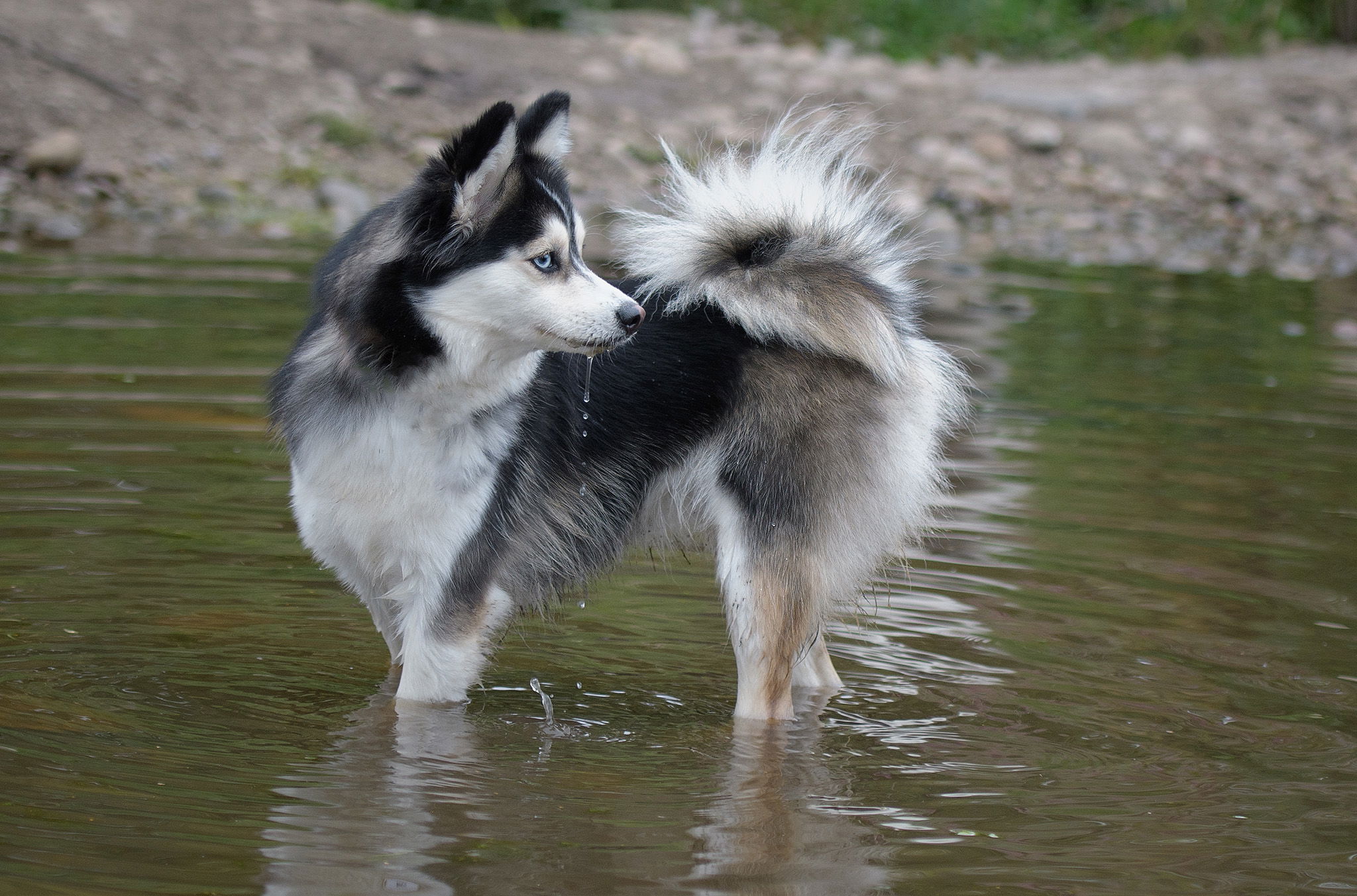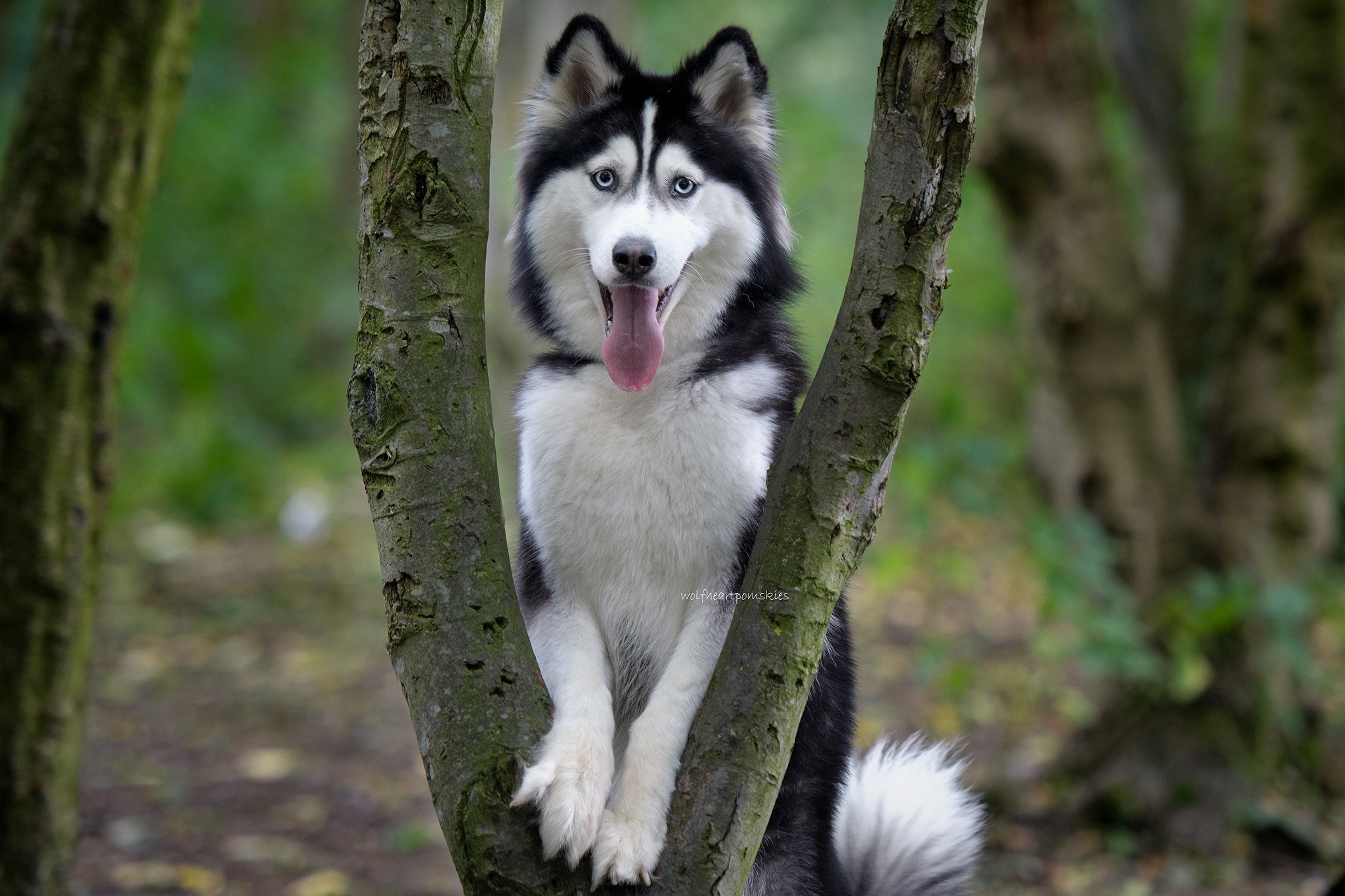Pomskies come in different sizes, different coat types and different colours and markings. They can have a mix of traits, may have more Pomeranian traits or more Husky traits. Despite these differences they have similar traits amongst them all and they have their breed's needs.
The Breed’s Needs
When considering the breed’s needs, we need to consider both foundation breeds and the traits that have been bred into them for 1000s of years. Though we can selectively breed our parent dogs and choose those who complement each other (like a calm laid back parent with a more sassy, energetic parent dog) but they have genetic predispositions that would take 1000s of years of careful selective breeding to breed those out of them.
Pomskies:
- Most like to dig- new pomsky owners sometimes get a shock when they see their puppy digging deep holes… Be prepared for it and adapt, provide an area that they are allowed to dig. We have a small area that they can dog in and have made it safe. We removed the soil, laid weed membrane fabric down, put guttering down with holes in for drainage and put soil on top. They cannot dig too far and we know that soil has nothing dangerous in.
- noise- some like to talk, a few howl, some are quiet. Sometimes those who are yappy haven't yet learned another way to communicate with their human. I strongly recommend engagement games and learning how to read dogs so you can act quicker. My pack communicates silently- so much can be read in their face, and body language and I act accordingly so they never felt the need to bark to ask for something. Though some will bark when they get excited like when visitors come into the home- this is something many owners and breeders have noticed. Within minutes they soon calm down and go back to relaxing.
- They need mental stimulation- not only is it fun but it tires them out. There are many methods of mental stimulation and it can be tailored to each dog as an individual. Everyone in the family can get involved from preparing lickimats, making obstacle courses, making puzzle treat feeders and interacting with creating games.
- They need to be exercised- a minimum of 2 x 30min walks a day when they are an adult. Time at enclosed fields is a great way for them to get rid of their energy, have fun, do training, and it is a good source of enrichment. I have heard husky and pomsky owners complain that they have to walk their dog for hours a day. I have never needed to do that because they get the right mental stimulation and training. Walking for long periods increases their stamina so they will need to be walked for longer to tire them out. When we do long walks, we build it up so we do not put a lot of stress on their joints and to build up their stamina.
- They are all companion dogs and value human interactions. Pomeranians are bred solely as companion dogs and huskies were bred to protect the family and keep them warm at night. Some Pomskies struggle with separation anxiety. I do recommend buying a Pomsky from a breeder who has already started training around separation anxiety and will provide ongoing advice around it so it does not become a problem.
- Huskies were bred to pull sleds and so many will naturally be inclined to pull on the lead. Breeders can start lead training and provide advice to new owners to help them get lead training off to the best start. During their teenage phase, many will start pulling but this can be managed. Some owners opt for haltis and headcollars but this is not my preference. I want to walk my dogs where they can still feel in control and I can allow them to have unstructured parts to to their walks so they can just be themselves.
- They are natural pack dogs and enjoy playing and interacting with other dogs, especially those with the same play type. I help to organise playdates around the UK and I also organise playdates solely for my pack and our puppies.
- They have to be socialised well and socialisation must be ongoing. This is the same for all breeds but it is something I will highlight to all my puppy owners. They will be calmer in different situations, be more confident, able to make the right decisions in sudden new situations and be overall easy to live with if socialisation has been done correctly.
- They have grooming requirements and will shed. It works out a lot cheaper if you can do the grooming yourself and if you're like me, you will find it therapeutic. If you can; abide fur around the home, in your cup of tea, in your food and in all sorts of random places- they are not the breed for you. I have 7 pack members and I manage it with regular grooming, a dryer, lint rollers and regular hoovering. Sometimes you just have to accept you are covered in fluff.
- Water play is something that Huskies and Pomeranians are not genetically programmed to enjoy yet it is becoming apparent in my Pomskies and their puppies that they LOVE water. Ponds, lakes, the sea, paddling pools, muddy puddles… they love it. Part of me thinks this is a confident thing but some, like Raven, will hear water and they will suddenly appear to see if they can play in it. Raven snorkels in water and has encouraged some of my others who weren’t keen initially to enjoy playing in it.
- I have heard other owners say they see a stubborn trait in their Pomskies. I will be honest- I have not seen this in mine. Maybe it is a mix of their traits, engagement games, my experience, and my education around dogs that has helped me to manage them so that we work well as a team.

Pomskies make great family dogs and companions. I cannot and wouldn't want to, imagine life without them. Some are easier to train than others. The ones from good breeders have been the easiest from the start. A lot of time, effort and training goes in to each of them as individuals. I spend pretty much all day, every day with them and I love that. I monitor them all the time so if an issue arises, I can address it straight away. I want them all to be happy, to have their needs met and live the healthiest, longest life possible.
Reputable breeders
Buying a Pomsky from a reputable breeder means that you are buying a Pomsky that has had the best start to life. They have started training in many areas, got socialisation off to a great start, and have pre-prepared their Pomsky for life. They will also guide you to the puppy that most suits you and your lifestyle. I know this sounds off putting but think of it like this.. A strong husky natured Pomsky puppy gets chosen by a family who aren’t particularly active, are out of the home for long periods of time, do not have the time or motivation for training- it is a recipe for disaster. That puppy needs more training due to the husky traits. They will get destructive because they are bored. They will howl when left alone.
A good breeder will get to know you and if they think a Pomsky isn’t the right fit for you, they will be honest and let you know why. They may be able to suggest a more appropriate breed.
Case story- Astra
I came across Astra in my search for a husky puppy. She was 13 weeks old and her then owners were struggling to cope with her. They said she was destructive, needed a lot of exercise and they go to work 9am til 5pm with someone checking in on her through the day.
I decided to go to meet Astra (was called Luna at the time) and I wanted to meet the owners in their home environment. The destructive behaviour sounded like boredom, she was left alone for too long and perhaps had little to no mental stimulation. She was their first dog and had no guidance from the breeder.

I was surprised to find them in a very small flat with a small balcony. Luna came to greet me and the way she did just melted my heart. Ears back to appear non threatening and she laid down on her back showing her belly. (I thought clearly she is not a dominant female.) She went to greet the rest of my family one by one and she approached my young sons in the most perfect way- silently and her body language was spot on. Luna was already the size of Raven and even though she was young, I could see some incredible traits that I truly value. I knew she would fit into the pack.
The car drive home was perfect, I stayed in the back with her to monitor her. Upon getting home, we got the other pack members on a small walk with Astra, one by one. We then allowed them together in the garden with me keeping watch. Despite Astra's size, she was a little scared. She had come into a home with an established pack. It did not take long for her to relax and start playing with the others. Raven's role as the dominant female means that she protects new pack members and the others respect her and listen without hesitation. This helped Astra immensely.
I have never seen any destructive behaviour from Astra. She gets the same walks as the others, the same time at enclosed fields and mental stimulation daily. She has been great on the lead and even though we can feel her strength, she doesn't pull.
Astra chose me as her favourite human and when relaxing, her place is by my left side on the sofa. Astra greets people and she naturally knows how to make them fall in love with her. I love watching her do it and I also enjoy watching the human. You see them slowly smile at this big dog who is asking gently for attention. You then see a huge smile on their face when Astra puts her ears back, face forward, eyes inviting them and then she lays on her back for tummy rubs. I can see such a sad look in her face and body language when people don't want to stroke her or when they cross the road to avoid her.
I was forewarned to not get a Husky. It was one of the best decisions I ever made.
Claire 🐾